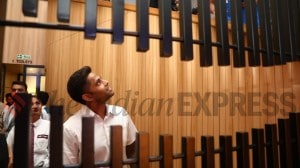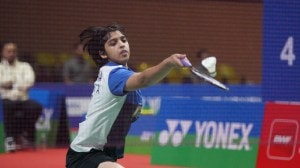BJP fears gap narrowing in Tripura as Left, Cong inch closer gingerly
"Left polled 42.22% votes in 2018, BJP 43.59%. In many seats, winning was very narrow. This is where the alliance can upset calculations," says a BJP leader
 Prime Minister Narendra Modi waves at supporters during roadshow ahead of the Tripura Assembly elections, in Gomati district (PTI)
Prime Minister Narendra Modi waves at supporters during roadshow ahead of the Tripura Assembly elections, in Gomati district (PTI) Over the years, come election season, the people of Tripura were attuned to images of Left Front rallies marching down the streets, renting the air with slogans of “Inquilab Zindabad, Long Live the Revolution”.
It is no wonder then that the visuals of Sudip Roy Barman, a popular face of the state Congress, raising the same slogan passionately during a joint march with the CPI(M) last week has emerged as a talking point in poll-bound Tripura.
On Friday, addressing another such joint event, AICC Tripura in-charge Ajoy Kumar virtually declared CPI(M) state secretary Jitendra Choudhary as the chief ministerial candidate of the two parties, which are still hesitant to call their pact a formal electoral “alliance”.
“Who is the tallest leader of your party CPI(M) who belongs to the Adivasi community? What is his name?” Kumar asked the crowd. As they shouted out the name of Choudhary, the Congress leader added, “Then I am telling you that your next CM will be a Leftist belonging to the Adivasi community.”
The two instances frame an unusual alacrity on the Congress’s part in accepting the CPI(M)’s commanding position in the equation between them. And the reason behind it is a growing concern that Congress votes might not get transferred to the Left easily, an apprehension that finds echo on the ground, in the plains and hills of the landlocked state.
“CPI(M) voters are committed to the party line. So Left votes will get transferred to the Congress, which is contesting in 13 seats. But traditional Congress voters, many of whom supported the BJP in 2018, will not readily vote for the CPI(M), even if they are disgruntled with the performance of the ruling party. That is because not every Congress voter will so easily forget the atrocities they faced during the Left rule,” says Dipankar Biswas, who owns a small water purifying unit in Agartala.
A Lokniti-CSDS analysis of poll data from the 2016 West Bengal Assembly elections, which were fought together in an arrangement by the Left and Congress, shows that the anxiety in the Opposition camp is not entirely unfounded. As per the data, 88% of those who had voted for the Left Front in the 2014 general elections backed the partnership. But among those who had voted for the Congress in 2014, as many as 24% voted for the Trinamool Congress in 2016, as per the analysis.
“We are walking the extra mile in trying to convince people that they should let bygones be bygones as the BJP is a diabolic force with no parallel,” asserts a Tripura Congress leader, who wished to remain anonymous.
However, it is not lost on anyone that with campaigning wrapping up in days, no top Congress leader has set foot in the state so far, even as top guns of the BJP have unleashed a campaign blitz.
On Saturday, addressing a rally in the state’s Dhalai district, Prime Minister Narendra Modi taunted the Opposition, saying “these parties do kushti (wrestling) in Kerala and dosti (friendship) here. How can they be trusted?”
Yet, the “understanding” between the past rivals has triggered a sense of disquiet among the BJP rank and file. “There is a difference between the collapse of the CPI(M) in West Bengal and the status of its Tripura unit. The Left polled 42.22% votes in the 2018 Tripura polls, while the BJP got 43.59%. In many seats, our margin of victory was very narrow. This is where the alliance can upset many calculations,” a BJP prishtha pramukh, who did not want to be named, says.
Also, while the BJP has been harping on the benefits of having a “double engine government (run by the party at the state and in the Centre)”, the message has very little resonance on the ground, which is rife with murmurs of discontent with its governance, particularly during the tenure of Biplab Deb, who was abruptly replaced with Manik Saha as the Chief Minister in May 2022.
“I voted for the BJP in 2018. But what have we got? The city of Agartala has seen some infrastructural development. But who knows when these projects were sanctioned? My son comes back home from school every other day and complains that classes were cancelled due to shortage of teachers. Supporters of rival parties were targeted needlessly in the first four years. One cannot rule out a hung Assembly this time,” says Partha Sarkar, an autorickshaw driver in Ambassa, which serves as the headquarters of Dhalai, an “aspirational district” (one of 112 under-developed districts which, under the Aspirational Districts Programme launched in 2018, was to be “quickly and effectively” transformed).
Some BJP workers too admit that they find their leadership “low on confidence” this time, as compared to 2018 when “many were willing to stick their neck out and pronounce a clear victory”. With every passing day, an impression is gaining ground that “the tally will come down significantly this time”.
“You go around Tripura, you will see people in a state of uncertainty. This is quite unlike 2018 when the desire for change was palpable. But the silver lining is that the appeal of PM Modi remains as strong as ever, particularly among a large section of the Bengalis, including Left supporters. Shobai jaane taine ektu alada (Everyone knows he is a little different from the others),” says Shambhu Pal, who hawks items on trains that ply between Agartala and Dharmanagar, located close to the Assam border.






- 01
- 02
- 03
- 04
- 05

























